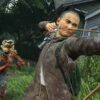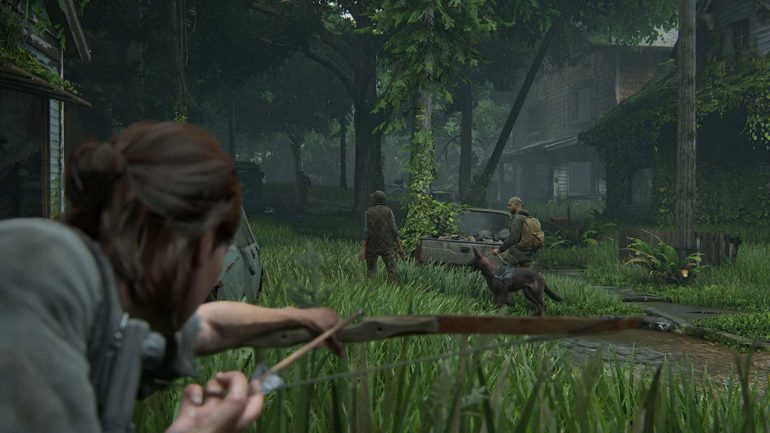If The Last of Us was about the lengths that humans are willing to go to for the ones they love, then The Last of Us Part II is about what they’re driven to do when that love is taken away.

As if it wasn’t clear enough already at this point, The Last of Us Part II is very much Ellie’s game. Where the original told a story through the eyes of Joel, establishing his place in a post-outbreak America and building up his surrogate parent relationship with Ellie, the new game puts Ellie on her own trajectory. In the early hours of the game, part of which I was lucky enough to be able to play this week, we see Ellie living out her days as a member of a sheltered community in Jackson, Wyoming (the very place that they find themselves arriving to at the end of ‘Part I’). Responsible for doing regular rounds scouting the immediate area, Ellie is joined by a new face – her friend, Dina – as the pair take to horseback to check that no stray Infected are encroaching on the town.
THE LAST OF US PART II COVERAGE
- The Last Of Us Part II Hands-On Preview
- Here’s 37 Glorious The Last Of Us Part II GIFS To Blow Your Mind
- Your The Last Of Us Part II Questions Answered
- Four Major Ways That The Last Of Us Part II Improves On The Original
- We Spoke To Naughty Dog’s Lead Game Designer About TLOU: Part II
These were the opening moments of my hands-on session and the most immediately apparent thing about The Last of Us Part II is just how incredibly gorgeous it looks. I shouldn’t be surprised, this is Naughty Dog we’re talking about, but the sheer level of detail in the world, the characters and in particular all of the animations, is truly second-to-none. Red Dead Redemption II might have had claim to the ”Most Frighteningly Realistic Horses” crown for a while now, but it faces some stiff competition here.
From the painstakingly detailed interiors full of brilliant environmental storytelling and incredible lighting direction, to a particularly panic-inducing snowstorm complete with unbelievable weather effects, this is one hell of a good-looking game. Going back to the first game ahead of this preview, I was reminded of just how far ahead of their time the animations were, especially for last-gen, and I wondered how much further Naughty Dog could feasibly take it. Turns out: very far. This game will no doubt be the benchmark for animation and art direction for years to come.

While the members of the Naughty Dog team present were reluctant to talk about where and how the game actually begins, this particular sequence definitely serves as the ‘tutorial’ segment, bringing players up to speed on the basics of movement, interaction and eventually combat, because it’s not long before the girls discover signs of Infected presence in a nearby abandoned supermarket. It’s here that the game reintroduces the very stealth-heavy combat encounters that were a hallmark of The Last of Us and, at least in this early area, things feel comfortingly familiar. Facing down a group made up of a few Runners and a couple of Clickers, that unmistakable feeling of tension comes flooding back as I plan my attack, figuring out how best to approach the situation. Do I take down my biggest threat, the deadly Clickers, first or do I quietly snuff out each of the Runners to avoid them alerting the others?
At a glance, the basic gameplay in these encounters is not all that different from the original game, with everything from the controls to the menus and enemy behaviours all feeling extremely familiar. That’s not to say that there haven’t been improvements made of course; Ellie’s movements and interactions with the environment are made all the more fluid and manageable purely by proxy of the much-improved character animations and physics. The stand-out change for me though, is the doing-away with the first game’s ‘shiv’ mechanic that tied powerful stealth kills to a diminishable item that was also needed for accessing certain doors. Now, Ellie carries around a switchblade that stands in for the shivs and (as far as I could tell) doesn’t run out or break. Brilliant.

Another big change, and one that presented itself both in these early enemy encounters as well as some prior exploration sequences, is in Ellie’s ability to traverse the game’s environments. Playing as Ellie in the Last of Us Part II feels tangibly different to playing as Joel (or even young Ellie) in the original, beginning with one important addition: a jump/climb button. Instantly adding significantly more verticality to both exploration and combat, the ability to do things like jump over gaps and clamber up objects and ledges is an obvious but very welcome change.
On top of that are dedicated controls for squeezing through tight gaps, which paves the way for some fun secret-hunting and convenient quick breakaways when being chased. While it’s hard to tell if they were more one-off scripted events than regular occurrences, there were also some cool moments involving throwing and climbing ropes. As far as familiar mechanics such as crafting and skill upgrades go, these seem mostly unchanged from the first game, albeit expanded in a few ways and with a slightly better UI. Seriously though, no more shivs!
Just from this introductory demo it becomes clear that the same duality in tone that the original game used so well is completely intact here. One minute, Ellie and Dina are riding horses through snow, talking about relationships and wondering where to get their hands on some weed; the next they’re skulking through dusty, dilapidated grocery aisles, murdering the mutated creatures that’ve set up shop there (pun intended). I get the impression that this approach extends to the story itself, too. Ellie, who’s now around 19 years old, is caught between trying to live a ‘normal’ life while also facing down pure horror on a regular basis in order to protect the people that she loves.
There’s a reason that Naughty Dog are considered masters of storytelling in the gaming sphere, and even from this very early glimpse at Part II’s narrative it’s clear that they love these characters and are passionate about the stories that they want to tell. It helps too that the world of The Last of Us, as bleak and desperate as every corner of its post-apocalyptic America is, is incredibly morally grey.

I love the more exploratory moments in The Last of Us, and they feel even more intriguing and rewarding in Part II, thanks in no small part to those new traversal mechanics making it fun just to discover out-of-the-way areas and uncover hidden secrets. One confronting discovery had me climb up into the second floor window of an abandoned house to find a handwritten note from a small child asking their parents for both a dog and a gun, in order to ‘keep the monsters away’. With everyone doing anything they can just to stay alive, these games force us to look at our own humanity and our relationships and ask ourselves what we would do for the people we love.
That’s where the second part of our demo comes in.
Fast-forwarding quite a ways into the game (though I admittedly don’t know exactly where), the next portion of our hands-on time with The Last of Us Part II takes place in Hillcrest, Seattle. Once a populated Quarantine Zone, this town has since been taken over by a militia-like group called the WLF (or more colloquially, the Wolves), who’ve seemingly rounded up the civilians and moved them away and are vehemently defending the territory. Outside of that, their motives aren’t overly clear at this point, save for definitely being bad guys as far as Ellie is concerned. At this point in the game (and again with very little context) it’s made clear that some kind of tragic event has driven Ellie out of the safety of Jackson and has her on a path that definitely feels a lot like it’s heading for some kind of revenge.

Even this one leap forward in time sees Ellie’s demeanor drastically change from the vulnerable, scrappy girl in Wyoming to something more akin to a hardened killer. In speaking about the game just ahead of our demo, the game’s much-revered creative director, Neil Druckmann, explains that the team wanted to explore themes beyond those of survival, and family, as they did in the original game. Part II certainly carries those same notes, but this time those ideals lead into and contribute to another natural emotional response to this oppressive and destructive world: rage. Whatever this mysterious tragedy is that sparks Ellie’s journey in Part II; it has her on an entirely different trajectory than we’re used to for her character. Here’s a young woman who has lost too much, and you can truly feel it and see it in this new gameplay sequence. Ellie is pissed.
Making my way through Hillcrest and fighting off or escaping the WLF is brutal. Not just in the shocking and intensely violent ways in which Ellie puts them to rest, but in the challenging new wrinkles to series’ established formula. Naughty Dog’s evolution of The Last of Us’ enemy encounters is more apparent here than in the first demo, and it all starts with dogs. True to their image, many of the Wolves patrolling the Seattle QZ are paired up with canine companions. These dogs present a new type of threat, one that works in synergy with that of their human counterparts.
Though Ellie’s options for stealth have expanded to include things like going prone and hiding in long grass, their heightened senses and close proximity to the ground means that the dogs are pretty quick to sniff her out. Part II’s subtly tweaked Listen Mode, which now presents enemies as indistinct blurs that sharpen up the closer you get to them, also highlights Ellie’s scent trail, making it important to reposition or create distractions whenever a dog is nearby. Though they’re dangerous enough on their own when attacking, the dogs’ main function is to alert all of the nearby enemies, so it’s in players’ best interests to take care of them quickly and quietly.

That’s not to say that the game’s human enemies haven’t also had a bump up in their effectiveness, and in fact this is where these encounters feel the most different from before. As opposed to their admittedly more basic behaviour in The Last of Us, humans in Part II work convincingly together as a unit and behave more reactively to both Ellie’s actions and their surroundings. Enemies will communicate their tactics to each other, ask for help or information, and even call each other by name (especially when you take one of them down). I can’t say it wasn’t just a little bit distressing to see the look on one of their faces when her dog fell victim to a well-aimed arrow right in front of her eyes.
Moving away from humans for a minute, it’d be remiss of me not to mention the one new Infected type that I came across during my playthrough; the Shambler. A hulking, aggressive enemy type that almost seems like a Clicker that’s been left alive for far too long and become overgrown, the Shambler also spews a kind of corrosive mist that lingers and makes it harder to get around. I’m not too sure of any other unique behaviours at the moment, mostly because my brief encounter with this new enemy involved dropping into a secluded basement and being swarmed by a group of them, resulting in a swift death, but I cantell you they take at least three point-blank shotgun blasts to go down.

Most interesting to me in this part of the demo was glancing over to a fellow Aussie journalist’s game running next to me and seeing a vast difference in the way his game was playing out compared to mine. He’d been playing the methodical, calculated killer all the way through, whereas at about the halfway point I decided I was going to try and just leg it. Where his game continued to present plenty of opportunity for small, thoughtful encounters that supported a stealth approach, in my game the WLF were mounting an all-out offensive that led to them pushing me through an almost scripted-feeling path through all the same areas that I would’ve otherwise been sneaking through. I asked game designer Emilia Schatz about this in our post-demo interview and she confirmed that the AI in the game is indeed designed to adapt to different playstyles and will even script in new enemies and situations to keep players on the right path no matter how they choose to get there.

There is so much to talk about and to digest about even the small slice of The Last of Us Part II that I experienced this week, and yet it’s still difficult to truly put any of it into context with how (admirably) quiet Naughty Dog are keeping about almost everything. I could tell you that, so far, this game feels like more of an evolution of the previous game than a revolution, and I’d probably be right, but who really knows? Either way, that’s far from a bad thing considering how damned fantastic the original was to begin with, and even the most subtle tweaks here go a long way to making this a worthy follow-up. At the end of the day, this is really about returning to the rich universe that Naughty Dog created, and bringing to life the new stories that they want to tell.
Though there was very little doubt to begin with, The Last of Us Part II is shaping up to be one of the most accomplished and talked-about games of this generation and beyond. It’s brutal, beautiful and brilliant. February 2020 can’t come soon enough.
Oh, and did I mention Joel’s back?



